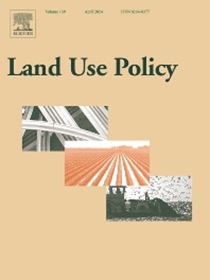Dynamic impacts of urban expansion on vegetation growth in urban environments: A sustainable land management framework
IF 6
1区 社会学
Q1 ENVIRONMENTAL STUDIES
引用次数: 0
Abstract
Urban expansion and vegetation growth are two highly interlinked and potentially contradictory global sustainability challenges. Urban expansion directly and indirectly influences vegetation growth in urban environments, either contributing to its loss or promoting its enhancement. However, previous studies problematized the double impacts of urban expansion on vegetation growth at a specific time, ignoring the dynamic relationships and evolving thresholds of indirect impacts over time. Here, a novel three-dimensional (3D) conceptual framework was proposed to explain the dynamic relationships between urban expansion and vegetation growth across China’s urban agglomerations (UAs) from 2000 to 2021. The corresponding thresholds of indirect impacts of urban expansion on vegetation growth were also quantified. Double-S thresholds of vegetation growth responses to urban expansion were found over time, including urban expansion intensity (UEI) and vegetation index (VI) thresholds. These thresholds showed strong climate dependence across climate zones, with higher UEI thresholds in humid zones and lower VI thresholds in semi-arid zones. Human activities explained higher contributions than climate change in the variations in double-S thresholds of indirect impacts. Based on above analysis, a sustainable land management framework was proposed to promote land restoration by integrating the dynamic impacts and double-S thresholds of urban expansion on vegetation growth. Furthermore, zoning management strategies were provided for precision land restoration across climate zones, including reducing negative direct impacts and enhancing positive indirect impacts. Altogether, these findings provide valuable insights and policy implications for long-term sustainable land management amidst evolving global environments.
求助全文
约1分钟内获得全文
求助全文
来源期刊

Land Use Policy
ENVIRONMENTAL STUDIES-
CiteScore
13.70
自引率
8.50%
发文量
553
期刊介绍:
Land Use Policy is an international and interdisciplinary journal concerned with the social, economic, political, legal, physical and planning aspects of urban and rural land use.
Land Use Policy examines issues in geography, agriculture, forestry, irrigation, environmental conservation, housing, urban development and transport in both developed and developing countries through major refereed articles and shorter viewpoint pieces.
 求助内容:
求助内容: 应助结果提醒方式:
应助结果提醒方式:


